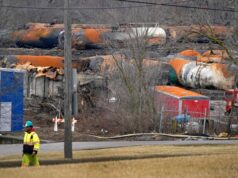
As governments have failed to take necessary action to contain the climate crisis and more evidence has become available showing that oil companies have spent decades lying to the public and shareholders, climate lawsuits have become increasingly common. Despite this, a new report from the Environmental Law Institute shows judges—while sympathetic to the gravity of the climate crisis—refuse to rule in a way that would compel action.
The analysis looked at climate-related court cases in the U.S. and a dozen other countries. The cases varied widely, including nuisance and defamation suits such as those filed by nine cities and counties against major fossil fuel companies, constitutional claims like the major case where youth sued the U.S. government for infringing on their rights, and federal and state statutory cases such as those made under the National Environmental Policy Act. But a common theme emerged in the majority of cases across the board: “Courts, especially in the United States, have generally exercised restraint and deferred to the representative branches of government to devise solutions to the climate challenge,” the report said. In other words, defendants don’t need to deny climate science to avoid taking real action.
The widespread acceptance of the existence of human-caused climate change marks a major shift legal opinion about the climate crisis. The report traced this shift back to at least 2007, when the the Supreme Court sided with the plaintiffs in the landmark climate case Massachusetts vs. EPA. The ruling found that regulating greenhouse gas emissions falls under the Clean Air Act.
Thanks to the shift in public and legal opinion toward accepting climate science in the intervening 13 years, outright climate denial has fallen out of fashion in courts today. That’s become especially true because government agencies now have vast stores of data on climate impacts.
But that hasn’t meant there have been more watershed wins like the 2007 case. Instead, defendants have changed their tactics, arguing not about whether or not climate change is real or about if greenhouse gases cause it, but about what the legal implications of the climate crisis are.
For judges, climate cases now don’t hinge on the ability to questions about whether or not the climate crisis exists or is caused by human action, but about whether courts have the authority to do anything about it. In essence, the key issues are political: who can be held responsible for those actions, who should pay for them, and who has standing to sue in which courts.
New York’s case against energy corporations for knowingly contributing to the climate crisis was thrown out in 2018 after defendants like Exxon and Chevron frustratingly stated that “global warming is an important international issue that concerns every nation on Earth.” How, they asked, could specific corporations accept responsibility for a global problem? Never mind the fact that just 100 companies are responsible for over 70 percent of global greenhouse gas emissions or that oil companies funded a decades-long campaign of denial and delay that continues to this day. Despite that, the court agreed and threw out the suit while arguing it was “not for the judiciary to ameliorate” the climate crisis.
A federal court reached a similar conclusion in the suit filed by 21 youth plaintiffs brought against the U.S. government, which came to an abrupt conclusion earlier this year. Federal appeals judges killed the case not because they necessarily disagreed with the premise of the suit or the severity of the climate crisis, but that the case required policy decisions that the judicial branch could not execute without the executive and legislative branches of government.
“Legal doctrine provides plenty of off-ramps, like standing and ‘political question,’ for judges who are inclined to take them,” Jay Austin, a senior attorney at Environmental Law Institute, told Earther.
While judges take those off-ramps, the planet is continuing to warm at a dangerous pace. And with so little potential for climate action in the current U.S. executive and legislative branches of government today, the role of courts is more important than ever. There’s solid evidence that polluting companies and their enablers in government are responsible for the lion’s share of the crisis, which judges should accept as much as climate science itself. But the courts aren’t there yet, putting us all at risk.
“Courts…have an important role to play in a democratic society in separating fact from fiction,” the report said.
Austin noted there are counterexamples, though. Last year, the Netherlands’ Supreme Court granted victory to non-governmental organization the Urgenda Foundation and 900 citizens, who alleged that the Dutch government had done too little to prevent climate catastrophe. The government is now legally bound to cut carbon pollution to 25 percent below 1990 levels by the end of next year as a result. And in the U.S., Austin said judges have at least been willing to issue narrower rulings on climate and environmental laws. Last year, for instance, the Supreme Court held that the National Environmental Policy Act had been violated at least 12 times.
Under the Trump administration, however, many environmental statutes are becoming weaker. If U.S. courts remain, as Austin said, “deferential to the representative branches of government for purposes of fashioning solutions,” that could be a problem given the scope of action that’s needed in the coming decade.
Source: gizmodo.com








